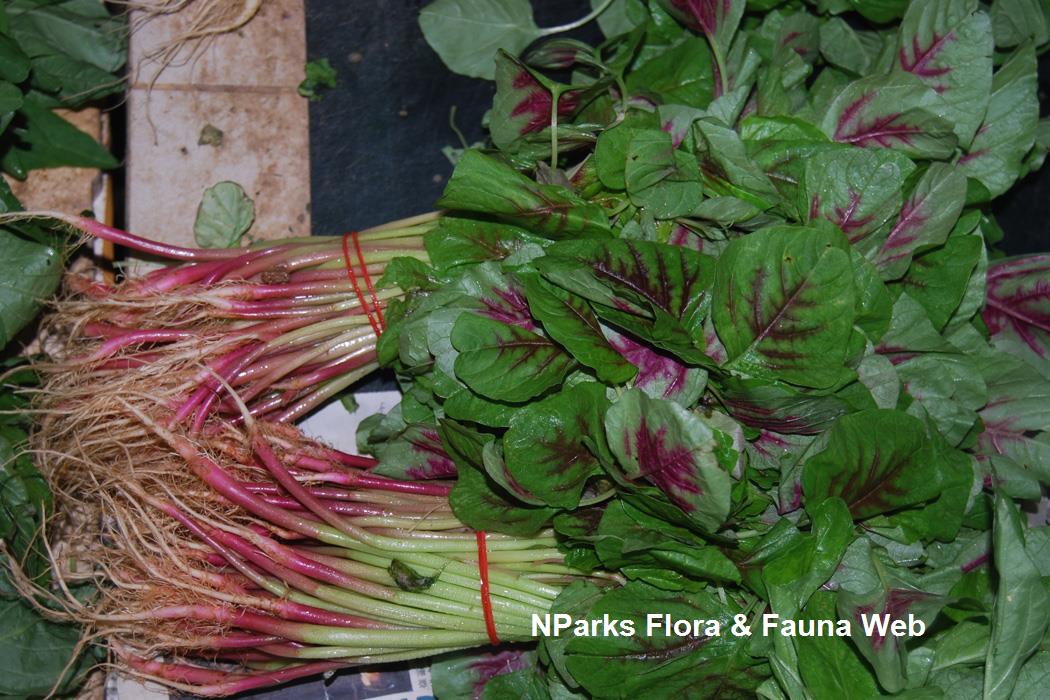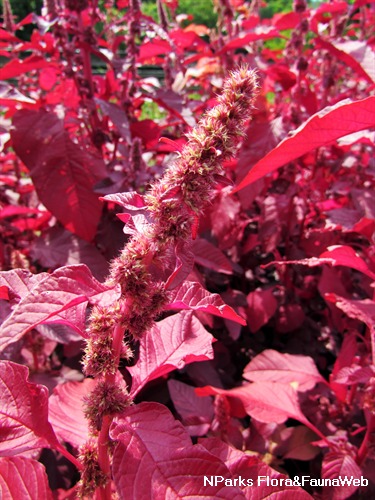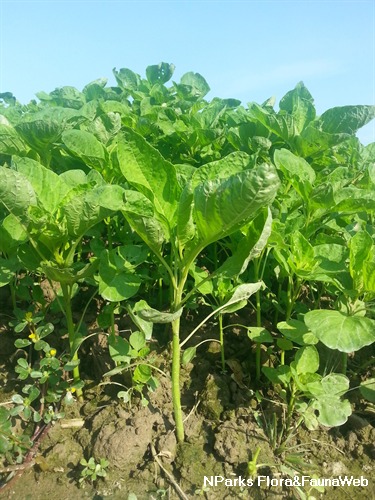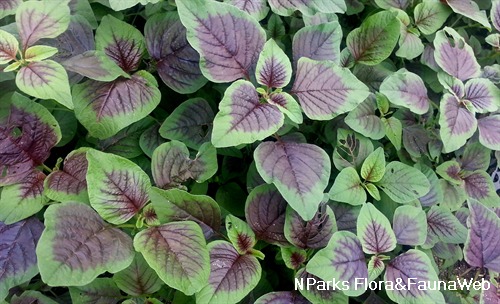
Back
Amaranthus tricolor L.
| Family Name: | Amaranthaceae |
| Common Name: | Chinese spinach, Tampala, Joseph's coat, 苋菜, 汗菜 |
Name
Classifications and Characteristics
| Plant Division | Angiosperms (Flowering Seed Plants) (Dicotyledon) |
|---|---|
| Plant Growth Form | Herbaceous Plant |
| Lifespan (in Singapore) | Annual |
| Mode of Nutrition | Autotrophic |
| Maximum Height | 1.5 m |
Biogeography
| Native Distribution | Tropical Asia, South-East Asia |
|---|---|
| Native Habitat | Terrestrial |
| Preferred Climate Zone | Tropical, Sub-Tropical / Monsoonal |
Description and Ethnobotany
| Growth Form | Erect, annual herb up to 1.5 m tall. |
|---|---|
| Foliage | Red or light to dark green leaves are elliptical to lanceolate (oval to lance-shaped) or broadly ovate (egg-shaped). |
| Flowers | Flowers occur in rounded clusters in the leaf axils (the space between the upper surface of the leaf and the stem). A spike inflorescence occurs near the stem tip which is typically short, but sometimes longer. |
| Fruit | Dry, dehiscent fruit is known as a capsule. It is covered by a lid-like opening and contains black, glossy seeds. |
| Cultivation | Grows well in fertile and well-drained soil in full sun conditions. It is tolerant to drought. The plant takes about 21 days from sowing to its first harvest. |
| Ethnobotanical Uses | Edible Plant Parts : Edible Leaves, Edible Stems Food (Fruit or Vegetable): The leaves are rich in minerals and consumed as a vegetable. They are eaten raw in salads or steamed. In Indonesia and Malaysia, it is one of the most popular leafy vegetables. Medicinal: The plant is believed to have medicinal properties. In folk medicine, it is used against external inflammation and treatment for bladder distress. A decoction of the root is used with Cucurbita moschata to control haemorrhage following abortion. A decoction of very old plants are taken internally to improve vision and strengthen the liver. Others: Yellow and green dyes can be obtained from the whole plant. |
Landscaping Features
| Desirable Plant Features | Ornamental Foliage |
|---|---|
| Landscape Uses | General, Parks & Gardens, Flowerbed / Border, Groundcover, Container Planting |
| Thematic Landscaping | Economic Garden |
Fauna, Pollination and Dispersal
| Pollination Method(s) | Abiotic (Wind, Self-Pollinated) |
|---|
Plant Care and Propagation
| Light Preference | Full Sun |
|---|---|
| Water Preference | Moderate Water |
| Plant Growth Rate | Fast |
| Rootzone Tolerance | Drought Tolerant, Well-Drained Soils, Poor Infertile Soils, Easy to Grow |
| Propagation Method | Seed, Stem Cutting |
| Seed / Spore Germination Duration | 3 days to 5 days |
Foliar
| Foliage Retention | Evergreen |
|---|---|
| Mature Foliage Colour(s) | Green, Green - Light Green, Red |
| Mature Foliage Texture(s) | Smooth |
| Foliar Type | Simple / Unifoliate |
| Foliar Arrangement Along Stem | Alternate |
| Foliar Attachment to Stem | Petiolate |
| Foliar Shape(s) | Non-Palm Foliage (Ovate, Lanceolate, Elliptical) |
| Foliar Venation | Pinnate / Net |
| Foliar Margin | Entire, Entire - Wavy / Undulate |
| Foliar Apex - Tip | Acute |
| Foliar Base | Cuneate |
| Leaf Area Index (LAI) for Green Plot Ratio | 4.5 (Shrub & Groundcover - Dicot) |
Floral (Angiosperm)
| Flower & Plant Sexuality | Unisexual Flowers , Monoecious |
| Flower Colour(s) | Pink, Purple, Red |
|---|
| Flower Grouping | Cluster / Inflorescence |
| Flower Location | Axillary, Terminal |
| Inflorescence Type | Spike |
Fruit, Seed and Spore
| Fruit Classification | Simple Fruit |
|---|---|
| Fruit Type | Dehiscent Dry Fruit , Capsule |
| Mature Seed Colour(s) | Black |
| Mature Seed Texture(s) | Smooth, Glossy / Shiny |
References
| References | Siemonsma, J.S. and Piluek, K. (Editors). 1994. Plant Resources of South-East Asia (PROSEA) No 8. Vegetables. Bogor, Indonesia: Prosea Foundation. |
|---|
Image Repository
Others
| Master ID | 31494 |
|---|---|
| Species ID | 5891 |
| Flora Disclaimer | The information in this website has been compiled from reliable sources, such as reference works on medicinal plants. It is not a substitute for medical advice or treatment and NParks does not purport to provide any medical advice. Readers should always consult his/her physician before using or consuming a plant for medicinal purposes. |

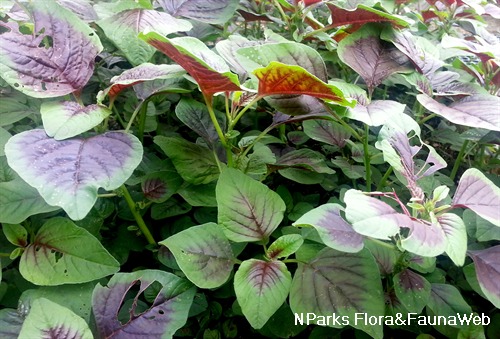
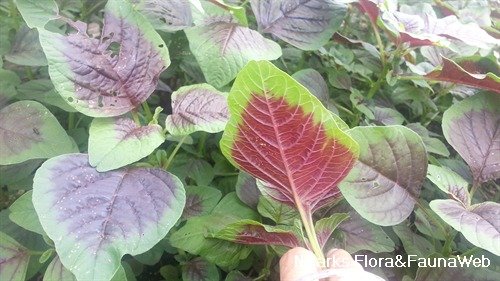

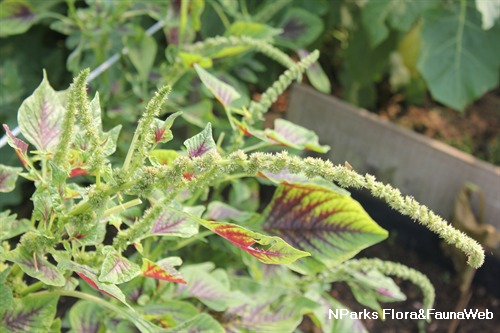
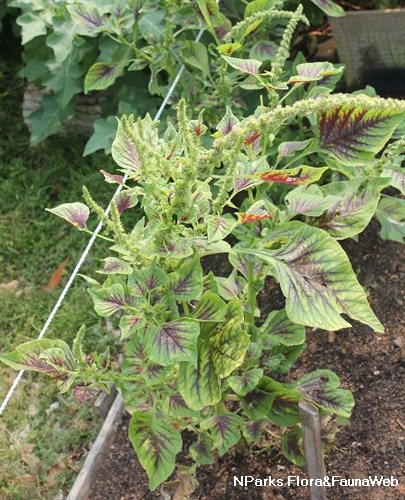
.jpg)
.jpg)
.jpg)
